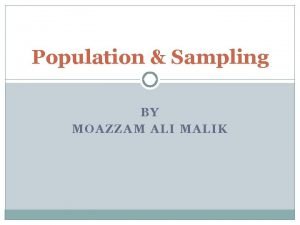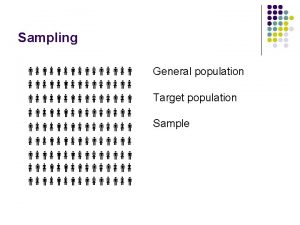Sampling Concepts Population Population refers to any group










- Slides: 10

Sampling Concepts • • Population: Population refers to any group of people or objects that form the subject of study in a particular survey and are similar in one or more ways. Element: An element comprises a single member of the population. Sampling frame: Sampling frame comprises all the elements of a population with proper identification that is available to us for selection at any stage of sampling. Sample: It is a subset of the population. It comprises only some elements of the population. Sampling unit: A sampling unit is a single member of the sample. Sampling: It is a process of selecting an adequate number of elements from the population so that the study of the sample will not only help in understanding the characteristics of the population but will also enable us to generalize the results. Census (or complete enumeration): An examination of each and every element of the population is called census or complete enumeration.

Advantages of Sample over Census �Sample saves time and cost. �A decision-maker may not have too much of time to wait till all the information is available. �There are situations where a sample is the only option. �The study of a sample instead of complete enumeration may, at times, produce more reliable results. A census is appropriate when the population size is small.

Sampling versus Non-Sampling Error �Sampling error: This error arises when a sample is not representative of the population. �Non-sampling error: This error arises not because a sample is not a representative of the population but because of other reasons. Some of these reasons are listed below: � Plain lying by the respondent. � The error can arise while transferring the data from the questionnaire to the spreadsheet on the computer. � There can be errors at the time of coding, tabulation and computation. � Population of the study is not properly defined � Respondent may refuse to be part of the study. � There may be a sampling frame error.

Sampling Design Probability Sampling Design - Probability sampling designs are used in conclusive research. In a probability sampling design, each and every element of the population has a known chance of being selected in the sample. Types of Probability Sampling Design �Simple random sampling with replacement �Simple random sampling without replacement �Systematic sampling �Stratified random sampling �Cluster sampling

Sampling Design Non-probability Sampling Designs - In case of nonprobability sampling design, the elements of the population do not have any known chance of being selected in the sample. Types of Non-Probability Sampling Design �Convenience sampling �Judge mental sampling �Snowball sampling �Quota sampling

DR DR DEEPAK CHAWLA NEENA SONDHI Determination of Sample Size The size of the population does not influence the size of the sample Methods of determining the sample size in practice: �Researchers may arbitrary decide the size of sample without giving any explicit consideration to the accuracy of the sample results or the cost of sampling. �The total budget for the field survey in a project proposal is allocated. �Researchers may decide on the sample size based on what was done by the other researchers in similar studies.

Determination of Sample Size Confidence interval approach for determining the size of the sample The following points are taken into account for determining the sample size in this approach. �The variability of the population: Higher the variability as measured by the population standard deviation, larger will be the size of the sample. �The confidence attached to the estimate: Higher the confidence the researcher wants for the estimate, larger will be sample size. �The allowable error or margin of error: Greater the precision the research seeks, larger would be the size of the sample.

Determination of Sample Size Sample size for estimating population mean The formula for determining sample size is given as: Where n = Sample size σ = Population standard deviation e = Margin of error Z = The value for the given confidence interval

Determination of Sample Size Sample size for estimating population proportion – 1. When population proportion p is known 2. When population proportion p is not known

• At 90 percent confidence Z=1. 645 • At 95 percent confidence Z=1. 96 • At 99 percent confidence Z=2. 575



















